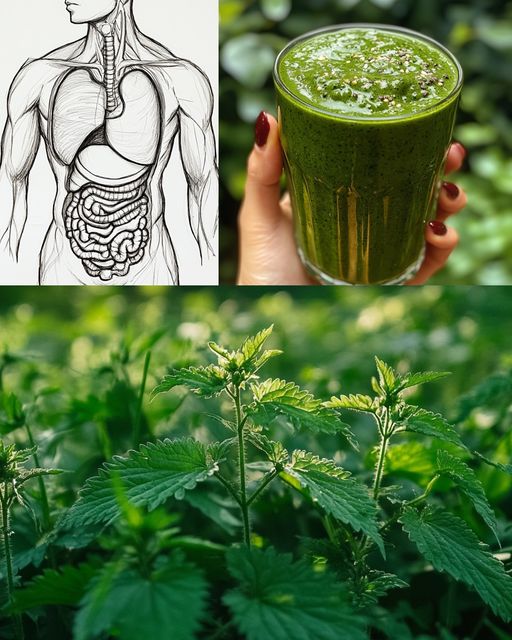The Power of Nettles: A Comprehensive Guide to Foraging, Benefits, and Preparation
Nettles, known scientifically as Urtica dioica, are often dismissed as mere weeds, but they are one of nature’s most versatile and nutrient-packed plants. Rich in vitamins, minerals, and antioxidants, nettles have been used for centuries in traditional medicine and cooking. This guide will explore how to safely forage for nettles, their benefits, how to avoid confusion with similar plants, and how to prepare them in various ways, including tea, smoothies, and soup.

Foraging Nettles: Where and When to Find Them
Nettles are commonly found in temperate regions across the world, particularly in Europe, North America, and Asia. They thrive in rich, moist soil and are often found in woodland areas, along riverbanks, and in fields. Nettles are most commonly foraged in the spring and early summer when the leaves are young and tender, which is the best time to harvest them for culinary and medicinal uses.
Identifying Nettles: Nettles are relatively easy to identify. They grow in clusters and can reach up to four feet in height. The leaves are heart-shaped with serrated edges, and the stems are covered with tiny, fine hairs. These hairs contain a mixture of chemicals, including formic acid, which can cause a stinging sensation when they come into contact with the skin.
Caution When Harvesting: It’s important to take precautions when foraging for nettles to avoid skin irritation. Always wear gloves, long sleeves, and pants to protect yourself from their sting. Use scissors or a knife to cut the top 4–6 inches of the plant, as this part contains the most tender leaves. Once harvested, the stinging effect is neutralized by cooking, drying, or crushing the leaves.
Avoiding Confusion with Similar Plants: Nettles can sometimes be confused with other plants, such as the dead-nettle (Lamium album), which also has serrated leaves but lacks the stinging hairs. Dead-nettles are harmless and even edible, but they don’t have the same medicinal properties as stinging nettles. Always ensure the plant has the characteristic sting before harvesting.
Nutritional and Medicinal Benefits of Nettles
Nettles are a nutritional powerhouse, offering a wide range of health benefits:
- Vitamins and Minerals: Nettles are rich in vitamins A, C, K, and several B vitamins. They also contain significant amounts of iron, calcium, magnesium, and potassium, making them an excellent supplement for overall health.
- Antioxidants: Nettles contain flavonoids and phenolic compounds, which are powerful antioxidants that help combat oxidative stress and reduce inflammation in the body.
- Anti-inflammatory Properties: Traditionally, nettles have been used to treat arthritis and other inflammatory conditions. They can help reduce joint pain and improve mobility when taken regularly.
- Digestive Health: Nettles are known to promote digestive health. They can help alleviate symptoms of constipation, bloating, and other gastrointestinal issues.
- Blood Sugar Control: Some studies suggest that nettles may help regulate blood sugar levels, making them beneficial for people with diabetes.
- Urinary Health: Nettles have diuretic properties, which can help flush toxins from the body and support urinary tract health.

Preparing Nettles: Tea, Smoothies, and Soup
Nettles are incredibly versatile in the kitchen. Here are three popular ways to prepare and enjoy them:
1. Nettle Tea: Nettle tea is one of the simplest and most effective ways to harness the plant’s benefits.
Ingredients:
- 1 cup of fresh nettle leaves (or 1 tablespoon of dried leaves)
- 2 cups of water
- Honey or lemon (optional)

Instructions:
- Rinse the fresh nettle leaves thoroughly to remove any dirt or insects.
- Bring the water to a boil and remove it from heat.
- Add the nettle leaves to the hot water and let them steep for 10–15 minutes.
- Strain the tea into a cup, add honey or lemon if desired, and enjoy.
2. Nettle Smoothie: A nettle smoothie is a great way to start your day with a boost of vitamins and minerals.
Ingredients:
- 1 cup of fresh nettle leaves
- 1 banana
- 1 apple, cored and chopped
- 1 cup of spinach or kale
- 1 tablespoon of chia seeds
- 1 cup of water or almond milk
Instructions:
- Rinse the nettle leaves thoroughly.
- Combine all the ingredients in a blender.
- Blend until smooth, adding more liquid if necessary to achieve your desired consistency.
- Pour into a glass and enjoy immediately.

3. Nettle Soup: Nettle soup is a traditional dish in many cultures, offering a hearty and nutritious meal.
Ingredients:
- 4 cups of fresh nettle leaves
- 1 onion, chopped
- 2 garlic cloves, minced
- 1 potato, peeled and diced
- 4 cups of vegetable broth
- 1 tablespoon of olive oil
- Salt and pepper to taste
Instructions:
- Rinse the nettle leaves and set them aside.
- In a large pot, heat the olive oil over medium heat. Add the onion and garlic, and sauté until they are soft and translucent.
- Add the diced potato and vegetable broth to the pot. Bring to a boil, then reduce the heat and simmer for 10–15 minutes until the potato is tender.
- Add the nettle leaves to the pot and simmer for another 5 minutes.
- Remove the pot from heat and use an immersion blender to puree the soup until smooth.
- Season with salt and pepper to taste, and serve hot.
Conclusion
Nettles are much more than a common weed; they are a treasure trove of nutrients and medicinal benefits. By learning to safely identify and harvest nettles, you can take advantage of this versatile plant to improve your health and enrich your diet. Whether you enjoy nettles as a tea, in a smoothie, or as part of a hearty soup, you’ll be tapping into a long history of traditional medicine and culinary practice. Remember to always handle nettles with care to avoid irritation, and enjoy the many benefits this remarkable plant has to offer.
